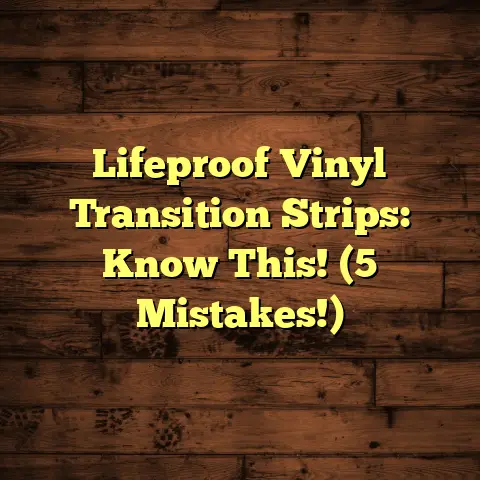Remove Floor Tiles Easily? (5 Pro Hacks!)
I’m excited to share some pro-level tips that will not only make your tile removal project a breeze but also keep our planet happy.
Introduction: Eco-Friendly Tile Removal
I’ve been in the flooring game for over 15 years, and one thing I’ve noticed is a HUGE shift towards eco-friendly home renovations.
It’s not just about what kind of flooring we install anymore, but also how we remove the old stuff.
More and more homeowners are looking for sustainable solutions that minimize their environmental footprint.
Removing tiles can feel like climbing Mount Everest barefoot, right?
But trust me, with the right approach, it’s totally manageable – and can even be kind of satisfying!
This article is all about giving you the insider knowledge to tackle tile removal like a pro, with a big focus on eco-friendly practices.
My goal is to show you that you can renovate your home beautifully while also being kind to Mother Earth.
So, get ready to dive into my top 5 professional hacks for easy tile removal, with a green twist!
Section 1: Understanding Different Types of Floor Tiles
Before you even think about picking up a hammer, it’s crucial to know what you’re dealing with.
Not all tiles are created equal, and the type of tile you have will significantly impact the removal process.
Let’s break down the most common types I see in homes:
-
Ceramic Tiles: These are the workhorses of the tile world – durable, affordable, and relatively easy to work with. They’re made from clay and fired at high temperatures.
-
Porcelain Tiles: Think of porcelain as ceramic’s tougher cousin. They’re denser, less porous, and more resistant to wear and tear. This also means they can be a bit more challenging to remove.
-
Vinyl Tiles: These are usually more flexible and often come with a peel-and-stick backing. However, older vinyl tiles might contain asbestos, so always test before you start any removal!
-
Natural Stone Tiles: This includes materials like granite, marble, slate, and travertine. These tiles are beautiful but can be brittle and prone to cracking during removal.
The type of adhesive used also plays a HUGE role. Some adhesives are water- based, while others are epoxy-based and incredibly strong.
You might find thin-set mortar, mastic, or even construction adhesive holding your tiles down.
This table summarizes the key differences and how they affect removal:
| Tile Type | Durability | Adhesive Type (Common) | Removal Difficulty |
|---|---|---|---|
| Ceramic | Moderate | Thin-set mortar, mastic | Moderate |
| Porcelain | High | Thin-set mortar | Challenging |
| Vinyl | Low | Peel-and-stick, adhesive | Easy to Moderate |
| Natural Stone | Varies | Thin-set mortar, epoxy | Moderate to High |
Understanding these factors will help you choose the right removal techniques and tools, setting you up for success (and saving you a lot of frustration!).
Section 2: Preparing for the Tile Removal Process
Okay, so you know what kind of tiles you’re dealing with.
Now it’s time to gear up and get prepared. This stage is crucial for both your safety and the environment.
Here’s my checklist:
-
Gather Your Tools: You’ll need things like a hammer, chisel, floor scraper, safety glasses, gloves, and a dust mask. I’ll recommend specific tools in each hack.
-
Protect Yourself (and the Environment): This is where the “eco-friendly” part really kicks in.
-
PPE: Instead of disposable dust masks, invest in a reusable respirator. Look for gloves made from recycled materials.
-
Cleaning Supplies: Ditch the harsh chemicals and opt for biodegradable cleaning solutions. Vinegar and water can work wonders!
-
-
Ensure Proper Ventilation: Open windows and doors to keep the air circulating. A fan can also help.
-
Waste Management: This is a big one. Don’t just toss everything in the trash!
-
Recycle Tiles: Check with your local recycling center to see if they accept tiles. Some construction and demolition waste facilities also have recycling programs.
-
Reuse Materials: Can any of the removed tiles be repurposed for another project? Maybe a mosaic or a garden pathway?
-
Proper Disposal: For materials that can’t be recycled, dispose of them responsibly according to local regulations.
-
I always recommend covering any furniture in the room with plastic sheeting. It might seem like overkill, but trust me, tile removal can get messy!
And don’t forget to protect your subfloor. A layer of plywood or hardboard can prevent damage during the removal process.
By taking these precautions, you’re not only ensuring your safety but also minimizing your impact on the environment.
Section 3: Pro Hack #1 – The Steam Method
Alright, let’s get into the good stuff! My first pro hack is the steam method, and it’s a game-changer for eco-friendly tile removal.
Here’s the deal: Steam loosens the adhesive without the need for harsh chemicals. It’s like giving the adhesive a gentle, spa-like treatment until it gives up its grip.
Here’s how to do it:
-
Rent or Buy a Steam Cleaner: You can find these at most hardware stores or rental centers. Make sure it has a floor attachment.
-
Prepare the Area: Clear the room and protect any surfaces you don’t want to get wet.
-
Steam Away!: Hold the steam cleaner over a section of tile for about 30-60 seconds. The heat will penetrate the adhesive and start to loosen it.
-
Pry and Lift: Use a putty knife or a thin pry bar to gently lift the tile. It should come up relatively easily.
-
Repeat: Continue steaming and prying until all the tiles are removed.
Tips for Maximizing Efficiency:
-
Work in Small Sections: Don’t try to steam the entire floor at once. Focus on small areas to maintain consistent heat.
-
Use a Scraper: A floor scraper can help you get under the tiles more easily after steaming.
-
Be Patient: Some adhesives are tougher than others. You might need to apply steam for a longer period of time.
I’ve found that the steam method is particularly effective for vinyl and ceramic tiles.
It’s also great for preserving the underlying subfloor, as it minimizes the risk of damage.
According to the EPA, reducing the use of chemical solvents in home renovations is crucial for protecting indoor air quality and preventing pollution. (Source: EPA website on indoor air quality)
The steam method aligns perfectly with this goal, making it a win-win for your home and the environment.
Section 4: Pro Hack #2 – The Use of a Floor Scraper
Okay, let’s talk about the floor scraper. This tool is your best friend when it comes to removing tiles efficiently and with minimal fuss.
Think of it as a giant, super-powered putty knife designed specifically for flooring.
Here’s how to use it:
-
Choose the Right Scraper: You’ll want a scraper with a long handle for leverage and a sturdy blade. Some scrapers have adjustable heads, which can be helpful for different tile types.
-
Get a Good Grip: Hold the scraper firmly with both hands. Position yourself so that you can apply steady pressure.
-
Slide and Pry: Slide the blade under the edge of the tile and apply pressure to pry it up. Work your way around the tile, loosening it as you go.
-
Persistence is Key: Some tiles will come up easily, while others will require more effort. Don’t give up!
Tips for Safe and Efficient Scraping:
-
Wear Safety Glasses: Tile shards can go flying, so protect your eyes.
-
Use Knee Pads: You’ll be spending a lot of time on your knees, so make yourself comfortable.
-
Sharpen the Blade: A sharp blade will make the job much easier. Use a file or a sharpening stone to keep it in good condition.
The beauty of the floor scraper is that it’s reusable and doesn’t require any electricity or chemicals.
It’s a simple, low-impact tool that can make a big difference in your tile removal project.
I’ve found that scrapers work well on most tile types, but they’re particularly effective for vinyl and ceramic tiles that are relatively easy to lift.
Plus, you’re getting a workout while you renovate! Who needs the gym?
Section 5: Pro Hack #3 – Leveraging Ice or Cold Water
This hack might sound a little crazy, but trust me, it works! The idea is that the cold temperature can help to shrink the adhesive and make it easier to break its bond with the tile.
Here’s the procedure:
-
Prepare Ice or Cold Water: You can use ice packs, ice cubes, or even just a bucket of ice-cold water.
-
Apply to Tile Edges: Place the ice packs or pour the cold water along the edges of the tiles you want to remove.
-
Wait: Give it some time, usually about 15-30 minutes, for the cold to penetrate the adhesive.
-
Try to Remove: After waiting, try to pry up the tiles using a scraper or chisel. The adhesive should be more brittle and easier to break.
Safety Tips and Expected Results:
-
Use Gloves: Protect your hands from the cold, especially if using ice for an extended period.
-
Expect Varied Results: This method works best on certain types of adhesives and may not be as effective on others.
-
Patience is Key: If the tiles don’t come up easily the first time, try applying the ice or cold water again and waiting a bit longer.
The environmental benefit here is clear: you’re completely avoiding the use of chemical solvents. It’s a natural, simple approach that relies on the basic principles of temperature and adhesion.
I’ve personally seen this work wonders on smaller tile projects, especially in bathrooms or kitchens where the tiles aren’t bonded with heavy-duty adhesives.
Section 6: Pro Hack #4 – The Use of a Heat Gun
Now, let’s turn up the heat – literally! A heat gun can be incredibly effective for softening stubborn adhesives and making tile removal a whole lot easier.
But remember, safety first! Heat guns get HOT, so you need to be careful.
Here’s how to use a heat gun for tile removal:
-
Gear Up: Wear safety glasses and gloves.
-
Set Up Ventilation: Work in a well-ventilated area, as heating some adhesives can release fumes.
-
Apply Heat: Hold the heat gun a few inches away from the tile, focusing on the edges. Move the gun back and forth to distribute the heat evenly.
-
Pry and Lift: As the adhesive softens, use a putty knife or a pry bar to gently lift the tile.
-
Repeat: Continue heating and prying until the tile is removed.
Safety Precautions:
-
Don’t Overheat: Avoid holding the heat gun in one spot for too long, as this can damage the tile or the subfloor.
-
Be Mindful of Fumes: If you notice any strong or unpleasant odors, stop and ventilate the area more thoroughly.
-
Keep a Safe Distance: Never point the heat gun at yourself or anyone else.
From an eco-friendly perspective, using a heat gun can reduce the need for chemical solvents, which is a definite plus.
You’re using heat to break down the adhesive instead of relying on harsh chemicals.
I’ve found that heat guns are particularly effective for removing tiles that are stuck with strong, epoxy-based adhesives.
Just be sure to take your time and work carefully to avoid any accidents.
Section 7: Pro Hack #5 – Employing a Hammer and Chisel
Let’s go old school! The hammer and chisel method is a classic approach to tile removal, and it’s still a viable option, especially for smaller areas or when you don’t have access to more specialized tools.
Here’s how to do it:
-
Position the Chisel: Place the chisel at a slight angle along the edge of the tile.
-
Strike with Hammer: Give the chisel a firm, controlled strike with the hammer.
-
Work Around the Tile: Move the chisel around the edges of the tile, gradually loosening it.
-
Pry and Lift: Once the tile is loose, use the chisel or a putty knife to pry it up.
Tips for Effective and Safe Use:
-
Wear Safety Glasses: Again, tile shards can go flying.
-
Use a Sharp Chisel: A dull chisel will just bounce off the tile.
-
Control Your Strikes: Avoid hitting the chisel too hard, as this can damage the subfloor.
The hammer and chisel method is about as sustainable as it gets. You’re using simple, reusable tools and relying on your own elbow grease to get the job done.
It’s a great option for those who want to minimize their environmental impact and avoid the use of power tools.
I often use this method for removing small sections of tile or for getting into tight corners.
It’s also a good choice if you’re working on a budget, as hammers and chisels are relatively inexpensive.
Conclusion: Your Eco-Friendly Tile Removal Journey
So, there you have it – my top 5 professional hacks for easy and eco-friendly tile removal!
Let’s recap:
-
The Steam Method: Gentle, effective, and chemical-free.
-
The Floor Scraper: A reusable workhorse for efficient removal.
-
Leveraging Ice or Cold Water: A surprisingly effective natural approach.
-
The Heat Gun: Great for stubborn adhesives, but use with caution.
-
Employing a Hammer and Chisel: The classic, sustainable method.
I hope this article has empowered you to tackle your tile removal project with confidence and a commitment to sustainability.
Remember, every little bit counts when it comes to protecting our planet.
By choosing eco-friendly methods and materials, you’re making a positive impact on the environment.
I encourage you to consider eco- conscious practices not just in tile removal, but throughout your entire home renovation project.
Whether it’s using recycled materials, reducing waste, or conserving energy, there are countless ways to make your home more sustainable.
Now I’d love to hear from you!
Have you tried any of these methods? Do you have any other eco-friendly tile removal tips to share?
Let me know in the comments below! And happy renovating!





